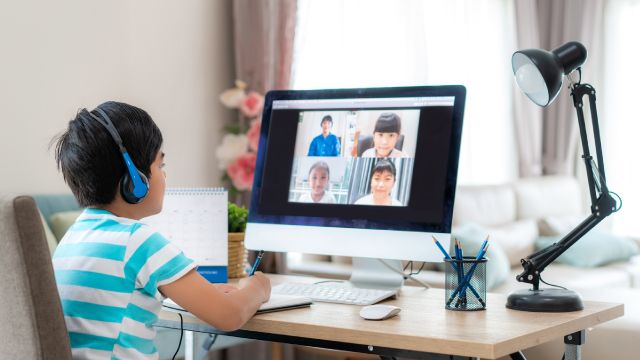Did you know that screen-time can cause eye problems such as digital eye strain? With the arrival of the COVID-19 pandemic, we have had to make some big changes to our lives. For many of us, we are now reliant on our digital devices to keep us connected more than ever. This goes for our children as well. With the introduction of the new school year, many school districts and parents are choosing to take an online-distance learning approach for their kid’s education. But what kind of toll can an increase in all this screen-time and digital device use take on our children’s vision and eye health? Well, read our blog article to find out!
Can Digital Devices Cause Vision Problems In Children?

It’s almost been a full year since the COVID-19 pandemic rocked our world (putting it gently). In order to reduce the spread of infection, we’ve had to spend more time apart which has resulted in more time at home. This has caused us to turn to our technology for both our work and play. But this is not only affecting us as adults. Our kids have also had to make this adaption as well. With the transition of in-school learning going online this past spring, many of our children have been required to use digital devices more and for longer lengths of time.
We are not only using our screens for education and work. But also to visit and stay socially connected to each other too. Parents working from home may also allow their children to use their digital devices more as a distraction, so the parents can get their own work done.
How Are Children Affected By Digital Devices?

The increase in using digital devices may lead to an increase in digital eye strain (computer vision syndrome) or other ocular complications. But how exactly is the increase in screen time affecting our kids?
Blue Light Exposure
Blue light is a wavelength of light that is emitted by digital devices. This type of light is harmful as it can have an undesired effect on both our eye health and sleep patterns. Exposure to blue light can make it hard for a person to fall asleep or have a restful sleep. It can also increase the risk of developing age-related macular degeneration later on in life.
What To Do For Blue Light Exposure – Use Blue Light Filters When Available
There are a few measures that parents can take to help reduce the amount of blue light exposure a child receives. First, limit the amount of computer/screen time your child has before bed. Experts say to stop using devices within 2 hours of bedtime, this allows our body to secrete the regular amount of melatonin (sleep hormone) needed for a good night’s rest. Second, if your child wears eyeglasses, purchase lenses that have a blue-blocking filter within the lens. You can also get blue-blocking filters for computer and tablet screens too. This not only reduces annoying glare, but it will also reduce blue light exposure as well.
Digital Eyestrain
Many children have a hard time identifying vision problems, this includes symptoms associated with digital eyestrain. Some vision problems that can occur as a result from digital eyestrain are tired eyes, dry eyes, blurry vision, and headaches. Because children are poor regulars with their time spent on digital devices, they tend to use them longer without breaks that put them at risk of problems and eyestrain.
What To Do – Regulate Device Use

As a parent, it is important to monitor and regulate how much screen exposure your child has. One way to do this is to have screen-free time scheduled into your child’s day. Pick a time (example 4:30-6:30) when your child is not allowed to use digital devices. If the child needs to use devices for school or homework, make sure they are taking breaks from the screen to give their eyes and visual system a rest. The best way to do this is by using the recommended 20-20-20 rule.
At 20 minutes, pick and object 20 feet away and have your child stare at that object for 20 seconds. For smaller kids, it may just be easier to give them a 1 or 2-minute break to take a walk around the room or house.
Myopia / Nearsightedness
Some research has shown that there is a connection to an increase in screen time and a child’s risk factor for becoming nearsighted (myopia). There are many more children developing myopia in the last few decades and the experts think that there is a direct connection with computer use amongst kids.
What To Do – Set a Healthy Example
Along with the tips above about regulating your child’s device use, it’s important as parents and role models that we set a healthy example. Do this by trying to limit your own digital device use. Set aside time for family time to connect together without televisions, phones, and computers. Make sure to get outdoors to move your body and enjoy some fresh air and sunshine. And don’t forget to schedule regular eye exams for ALL members of the family.
Technology is the way of the future but our kids are our future too! By taking some simple precautions with our approach to our children and their use of digital devices, we can help preserve their vision for years to come.
This article was written by Trina Vanaalst, licensed optician, and registered contact lens practitioner.




